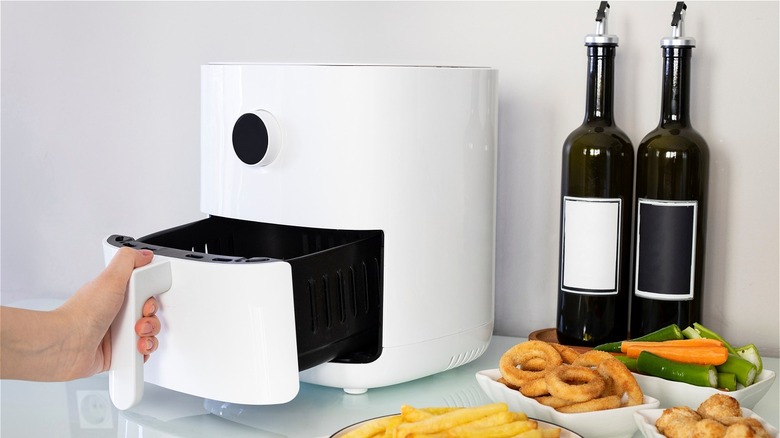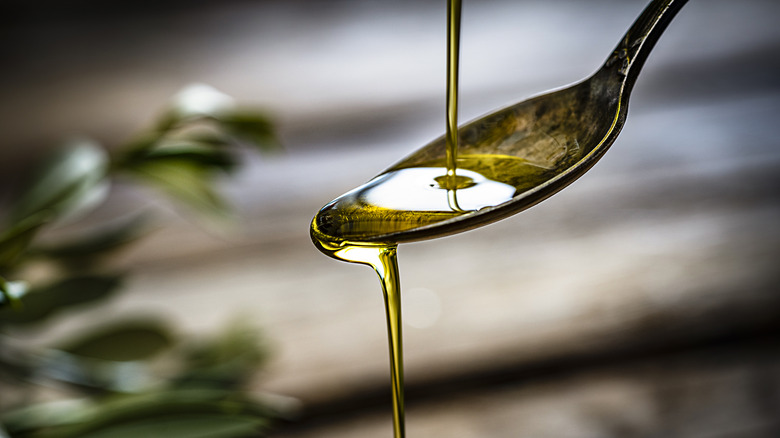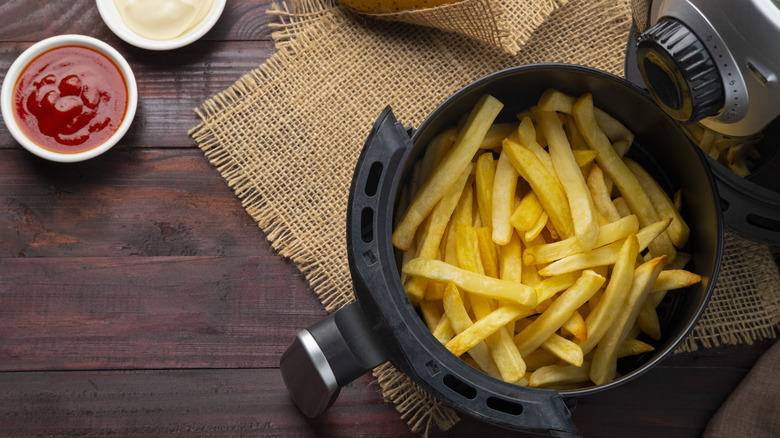For Perfectly Air-Fried Food, Use Less Oil Than You'd Think
Air fryers have taken over modern kitchens. From crunchy, air-fried pickles to coconut-crusted tofu, there are a million and one recipes to make with an air fryer. They work twice as fast as conventional ovens and tattoo your favorite foods with a beautifully blistered char — what's not to love? Although they are easy to use and perfect for foodies new to the art of cooking, there are some big mistakes to avoid when using an air fryer. One of them is using too much oil.
Using a hefty amount of oil is an easy mistake when cooking with an air fryer. After all, deep frying calls for loads of oil — so why wouldn't you follow suit with an air fryer? However, air fryers are specifically designed to reduce the amount of oil needed to fry, roast, and heat foods. In an air fryer, the cooking process relies on hot, circulating air to cook food. This hot air surrounds the food from all angles, effectively transferring heat to the surface of the food and causing it to brown and crisp, without using large amounts of oil.
When you make the mistake of adding too much oil to an air-fryer recipe, you may end up with a meal that's soggy, greasy, and doesn't hold its shape. Plus, more oil means more to clean up — no thanks!
Striking the right balance
Just because you don't need quarts of cooking oil to achieve a delicious char on your favorite air-fried foods, doesn't mean you have to omit oil altogether. A small amount of oil in an air fryer recipe facilitates the Maillard reaction, a chemical reaction between amino acids and sugars that results in an enhanced flavor, as well as a golden-brown char on the food's surface. But how much oil should you use?
How much oil you use depends on how much food you're cooking, but a good rule of thumb is one to three teaspoons of cooking oil. To effectively achieve the Maillard reaction, ensure the entire surface of your food has a thin amount of oil on it. The easiest way to accomplish this is by carefully tossing your ingredients in a bowl with oil and the seasonings of your choice. If you notice that large areas of the food's surface remain dry, carefully introduce a small amount until the ingredients are lightly coated. But bear in mind that — because they're already laced with oils — adding more oil to your air fryer can yield a soggy meal.
Fixing oily air-fried food
If you accidentally add too much oil to your air fryer, there are some ways to remedy the situation. That way, you can still enjoy the crunchy, crispy texture of air-fried food.
If the oil is visible on the surface of the food after air-frying, an easy way to fix this soggy situation is by gently blotting it with paper towels to absorb the excess. Simply press the paper towels lightly against the food to soak up the oil without disturbing the texture. If the excess oil has pooled at the bottom of the air fryer basket or tray, carefully remove the cooked food, then place the food on a wire rack set over a baking sheet to drain away excess oil as your meal cools.
If you are air-frying breaded foods, consider adding more breadcrumbs and cooking your recipe for a bit longer. This will help absorb some of the oil while giving the food a sturdier shape. If the food tastes extremely oily, consider balancing it out with additional ingredients — try sprinkling your food with salt, herbs, spices, or citrus zest to boost the dish's flavor while masking the oil.
The next time you're air-frying your favorite foods, don't go overboard with the cooking oil. Save that oil for deep-frying instead.


